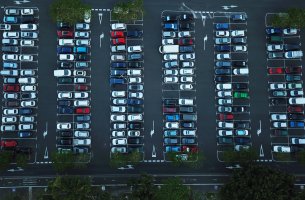jar546
CBO

"The Parking Predicament: How Zoning Ordinances Shaped America's Car-Centric Society and Housing Affordability Crisis"
The American dream of "the open road" in the 1940s and 1950s became a defining feature of U.S. culture. With the advent of the automobile, it seemed as though the country's vast expanses were an open canvas, waiting to be covered with highways and parking lots. However, what appeared as progress at the time has since revealed unintended consequences that continue to affect us today.
One of the significant contributors to America's car-centric society has been zoning ordinances that prioritized minimum parking requirements. While these regulations were initially well-intentioned, they have had far-reaching impacts on urban development, housing affordability, and the nation's tax base.
The Parking Plague: Affordable Housing and Lost Tax Revenue
In many American cities, zoning ordinances have demanded ample parking for businesses, residential buildings, and even public facilities. On the surface, this might seem like a prudent move to ensure adequate parking spaces for the growing number of cars. However, the unintended consequence has been the creation of vast parking lots that devour valuable urban land.
Consider this: a typical suburban shopping mall dedicates more land to parking than it does to actual retail space. The same principle applies to residential developments, office complexes, and educational institutions. This extensive allocation of land for parking not only diminishes the availability of land for other purposes, but it also reduces the taxable property base, leading to lower tax revenue for cities.
Moreover, the cost of constructing and maintaining these vast parking areas is substantial, a cost that is ultimately passed on to consumers and taxpayers. It's a hidden tax on everyone, with those who can afford it the least bearing the brunt of the burden.
The Proliferation of Urban Sprawl and Car Dependency
The car-centric zoning model has also encouraged urban sprawl. Cities that prioritized parking minimums inadvertently spread themselves thin instead of building up with greater density and diversity. This phenomenon resulted in the creation of sprawling suburbs, necessitating long commutes and contributing to traffic congestion, air pollution, and increased fuel consumption.
The absence of mixed-use areas, where residential, commercial, and recreational spaces coexist, has further entrenched car dependency. Residents often find themselves compelled to drive for even the most basic daily needs, from groceries to medical appointments, due to the separation of land uses and lack of pedestrian-friendly environments.
The Missed Opportunities for Public Transportation
While Europe and other parts of the world invested in robust public transportation systems, the U.S. lagged behind, primarily due to the allure of the automobile. Passenger rail systems, which thrive in densely populated areas, were often sidelined in favor of expanding highways and accommodating more cars.
A Path Forward: Rethinking Zoning and Urban Planning
It's time to reconsider the impact of parking-centric zoning ordinances on our communities. To address the affordable housing crisis, ***** tax revenues, and reduce car dependency, cities should:
- Revise Parking Requirements: Cities should reevaluate and revise their parking requirements to match actual demand, considering factors such as proximity to public transit and walkability.
- Promote Mixed-Use Development: Encourage mixed-use zoning that allows for a blend of residential, commercial, and recreational spaces, creating vibrant, walkable neighborhoods.
- Invest in Public Transportation: Prioritize investments in public transportation, including passenger rail systems, to provide alternatives to car travel and reduce congestion.
- Implement Smart Growth Policies: Embrace smart growth policies that emphasize compact, sustainable, and efficient land use patterns.
